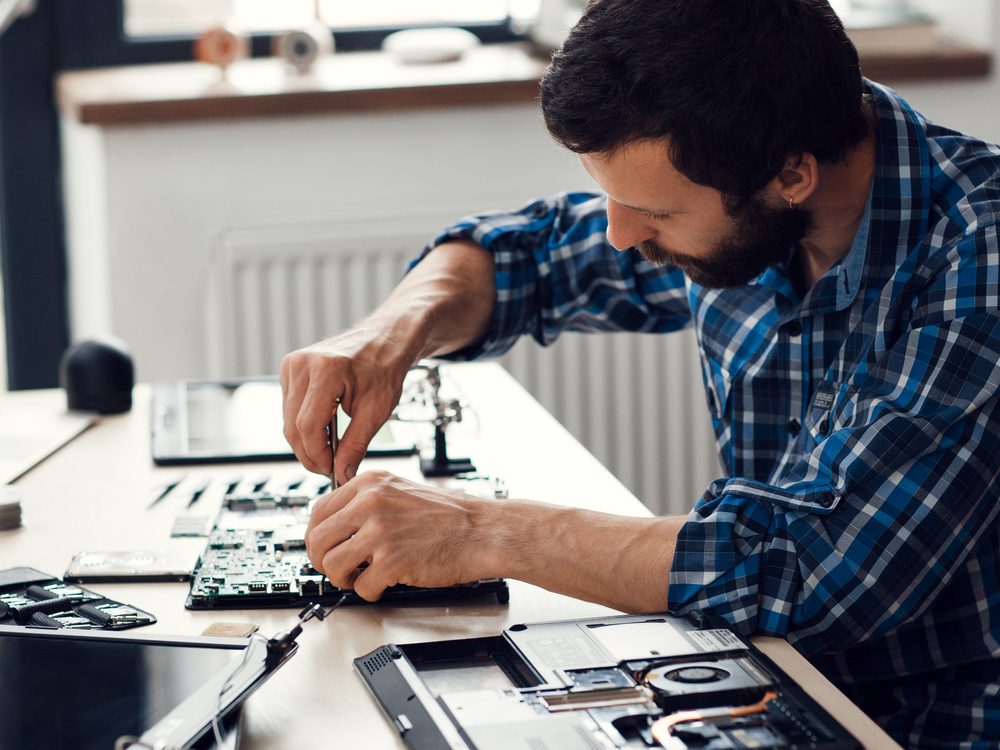
Why learning how to buy less is an important lesson
Sarah Lazarovic used to love window-shopping on her way to and from her job as a web producer at the CBC. But in 2012, a few years after the mother of two began working from home as a freelance illustrator, the windows she gazed at most often became those on her Internet browser—ones whose marketing algorithms targeted her specific desires.
“I’d go down a rabbit hole and spend hours browsing online shops,” she says. Tired of wasteful consumption, and wasted time, Lazarovic committed to not buying any clothing for an entire year. Instead, whenever she came across an item she wanted, she would paint a picture of it. “It was a way of both mitigating desire and having a creative exercise.”
In order to help herself consume more thoughtfully in general, Lazarovic created a “Buyerarchy of Needs”—an illustrated pyramid chart mimicking psychologist Abraham Maslow’s hierarchy of needs—which lists the myriad ways one can acquire something, from most to least sustainable: use what you have; borrow; swap; thrift; make; buy.
Whether due to changing financial circumstances or a wish to lead a more self-sufficient lifestyle, many Canadians are striving, or are forced, to buy less. It doesn’t have to be a loss, though, and there are plenty of ways to make the transition easier.

Lending instead of spending
Maintaining a stable standard of living in any major city today is challenging, especially for the under-30 set—and it’s this demographic that’s responded in recent years by launching digital platforms that make being thrifty easier. While millennials have been the first to embrace this budding sharing economy—whether it be an app that lets you split a taxi ride or a website that facilitates swapping household items—older generations are increasingly hopping on board as well.
One of the most popular Canadian sites, Bunz, began in 2013 as a private Facebook group set up by Emily Bitze for Toronto residents to facilitate the bartering of goods and services. Bitze would post a message explaining, for instance, that she had a blender she wasn’t using and ask if anyone on the site wanted to exchange it for a few houseplants or one of the other items on her “wish list.”
The Bunz app now has more than 200,000 users, growth that CEO Sascha Mojtahedi says comes down to simple necessity: “When you’re long on things and short on cash, how can you take those things you’re not using and get what you need for what you have?”
But he points out that those who participate benefit beyond just saving money. “Bunz lets you connect with other people in your city. It’s highly social because it’s built around commonality and mutual interests.” Two stamp collectors, for instance, may arrange a trade at a local café and spark a new friendship.
If you can’t find someone to barter with, borrowing is often still better than buying, and a quick Internet search can help you find places to rent everything from home-renovation tools to cross-country skis.
If borrowing isn’t an option and you do need to buy, here’s how to save money in Canada on everything from groceries to medications.

If it’s broken, fix it
At a time when almost anything can be purchased with just one click, it’s become an automatic response to simply replace what breaks. Generations raised in the earlier half of the 20th century can attest, however, that this wasn’t always so: household appliances, clothing, electronics and more used to be bought under the assumption that, with the occasional home repair, they would last a lifetime.
Now, some conscientious consumers are taking matters into their own hands and joining the burgeoning Repair Café movement. Founded in Amsterdam in 2009 by sewing expert Martine Postma, the original non-profit has expanded to more than 1,500 locations worldwide. These pop-up events, which are run by volunteers, offer lessons in how to fix anything from an unravelled hem to an unresponsive laptop.
“There’s juice and treats and you get to meet new people,” says Bennett McCardle, a retired civil servant and volunteer fixer at the Repair Café Toronto, where she mends jewellery. She brings her own specialized tools but says most items could be repaired by anyone with a pair of pliers and some determination. “I taught a woman how to do pearl knotting recently, then sent her home with instructions and a YouTube video.” In turn, the 66-year-old has gleaned valuable lessons from fellow volunteers, like how to fix watch straps and eyeglass frames.
For McCardle, the mission to extend the lifespan of our belongings is as much a matter of principle as it is about being frugal: “Something that is broken took time and resources to make, so if you’re throwing it out, you’re wasting those resources.” If you can’t find a Repair Café near you, it’s easy to start one. RepairCafe.org offers a starter manual with step-by-step instructions.
You don’t have to wait until something breaks to give it a DIY upgrade. Here’s how to make stuff last longer from the start, saving you money and resources in the process.

Learn to thrive with less
Changing how we acquire things is necessary, but there’s also something to be said for simply not getting them in the first place. “Most of us have more than what we need,” says Marina Ramalho, the first Canadian consultant trained in the KonMari method of decluttering, made popular by Marie Kondo’s book The Life-Changing Magic of Tidying Up. “This can lead to a lot of anxiety—like, think about everything stuffed in the back of your closet; do you own those things or do they own you?”
Ramalho suggests we can train ourselves to make mindful purchases instead of impulse buys. One of her tips for preventing unplanned splurges: pause before you walk up to the cashier or hit the “buy now” button and ask yourself: Would I buy this item at full price? Does this shirt go with everything in my closet? Do I need to have this right now or can I sleep on it? She also recommends writing down the item you want or bookmarking it on the computer, then returning to it a week later to gauge whether it’s still as enticing.
Lazarovic, whose delayed gratification went even further, explains that less shopping has freed up more time for family activities, dinner with friends and making art. She continues to paint her retail cravings whenever they strike; by doing so, as she puts it, “I get out of that need-to-buy-it frenzy and in the end I feel good that I’ve made something.”
Now that you know how to buy less, discover eight ways to save money on groceries.